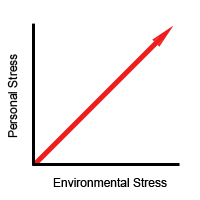Since the earliest times, humans have needed to be sensitive to their surroundings to survive, which means that we have an innate awareness of our environment and seek out environments with certain qualities.
First of all, humans have a strong need for safety and security and look for those attributes in their environment. We also look for physical comfort, such as an environment with the right temperature. In addition, we seek an environment that is psychologically comfortable: for example, environments that are familiar, but offer the right amount of stimulus. 
Retailers
and the hospitality industry know this very well and try to provide an
atmosphere that creates a positive customer experience and offers three
important attributes: comfort, safety, and entertainment. These
attributes are equally important in healthcare as well.
Below are just a few examples of how the environment can impact you.
- The environment can facilitate or discourage interactions among people (and the subsequent benefits of social support). For example, an inviting space with comfortable chairs and privacy can encourage a family to stay and visit with a patient.
- The environment can influence peoples' behavior and motivation to act. For example, a dingy corridor filled with extra hospital equipment will invite staff to leave another item in the hall, whereas a clean corridor and adequate storage will encourage staff to take the time to put the item away.
- The environment can influence mood. For example, the results of several research studies reveal that rooms with bright light, both natural and artificial, can improve health outcomes such as depression, agitation, and sleep.
 What about stress?
What about stress?
Perhaps
most importantly for health, the environment can create or reduce
stress, which in turn impacts our bodies in multiple ways. This is
because our brain and our nervous, endocrine, and immune systems are
constantly interacting. As neuroscientist Candice Pert puts it, "What
you are thinking at any moment is changing your biochemistry."Thus, the stress of a noisy, confusing hospital room might result in a patient not only feeling worried, sad, or helpless, but experiencing higher blood pressure, heart rate, and muscle tension. In addition, hormones released in response to the emotional stress could suppress the patient's immune system, causing his wounds to heal more slowly.
Stress is an important medical consideration, and creating an environment that reduces stress is a key piece of improving health outcomes.
For more information on stress and how it impacts the body, see Mind-Body Therapies.
What is the evidence?
There is a great deal of very rigorous research that links the physical environment of hospitals to health outcomes. According to Ulrich and Zimming, authors of the 2004 report, The Role of the Physical Environment in the 21st Century Hospital, there are more than 600 credible studies that show how aspects of healthcare design can influence medical outcomes.Essentially, this research shows that the conventional ways hospitals have been designed contribute to stress and adverse patient and staff outcomes. Poor design can adversely impact health and wellbeing, as well as staff productivity and ability to deliver great patient care. For example, because of poor design, nurses in most hospitals spend a great deal of time just gathering the material they need for care. One study showed that almost one-third of nursing staff time was spent walking. (Ulrich, p5.)
On the other hand, improving the physical environment can make healthcare settings less stressful, safer, and better places to work.
 Experts
in the new area of evidence-based design have identified five
environmental attributes that can have a large impact on health
outcomes. The research demonstrates that improvement in these areas reduces stress and improves patient outcomes:
Experts
in the new area of evidence-based design have identified five
environmental attributes that can have a large impact on health
outcomes. The research demonstrates that improvement in these areas reduces stress and improves patient outcomes:- Increase connection to nature. Many studies produce strong evidence that even three to five minutes of contact with nature can significantly reduce stress and have a complex impact on emotions, reducing anger and fear and increasing pleasant feelings. This effect can be achieved by providing: views to the outside, interior gardens or aquariums, or art with a nature theme.
- Offer patient options and choices. This increases the patient's sense of control, which can significantly lessen stress. Options include the ability to: adjust lighting and temperature, choose music, select places to sit, and control the timing of meals. In addition, better wayfinding (signs and information about where to go) reduces disorientation and helps patients feel in control, as does better hospital layouts that allow frail patients to be more independent in getting around.
- Enhance social support. There is extensive evidence that social support from family and close friends has important benefits. For example, studies show that social support improves recovery in heart patients, and emotional wellbeing and quality of life in late-stage cancer patients. Social support can be enhanced by providing waiting rooms and lounges with comfortable furniture that can be arranged as desired, designing patient rooms to accommodate visitors, and making it comfortable for visitors to stay overnight.
- Reduce environmental stressors such as noise, glare, and poor air quality. Noise causes stress (as evidenced by increased heart rate and blood pressure and reduced oxygen levels in the blood in both adults and babies) and is related to adverse medical outcomes. Good design can reduce noise from paging systems, equipment, alarms, roommates, and staff by reducing the sources and by increasing sound absorption.
 Provide pleasant diversions.
In one example, heart surgery patients in intensive care who viewed
nature (landscape scenes) reported less anxiety/stress and needed fewer
pain medications than a control group with no pictures. Diversions may
include: artwork of nature (not abstract art), fireplaces, videos of
nature, and aquariums.
Provide pleasant diversions.
In one example, heart surgery patients in intensive care who viewed
nature (landscape scenes) reported less anxiety/stress and needed fewer
pain medications than a control group with no pictures. Diversions may
include: artwork of nature (not abstract art), fireplaces, videos of
nature, and aquariums.








No comments